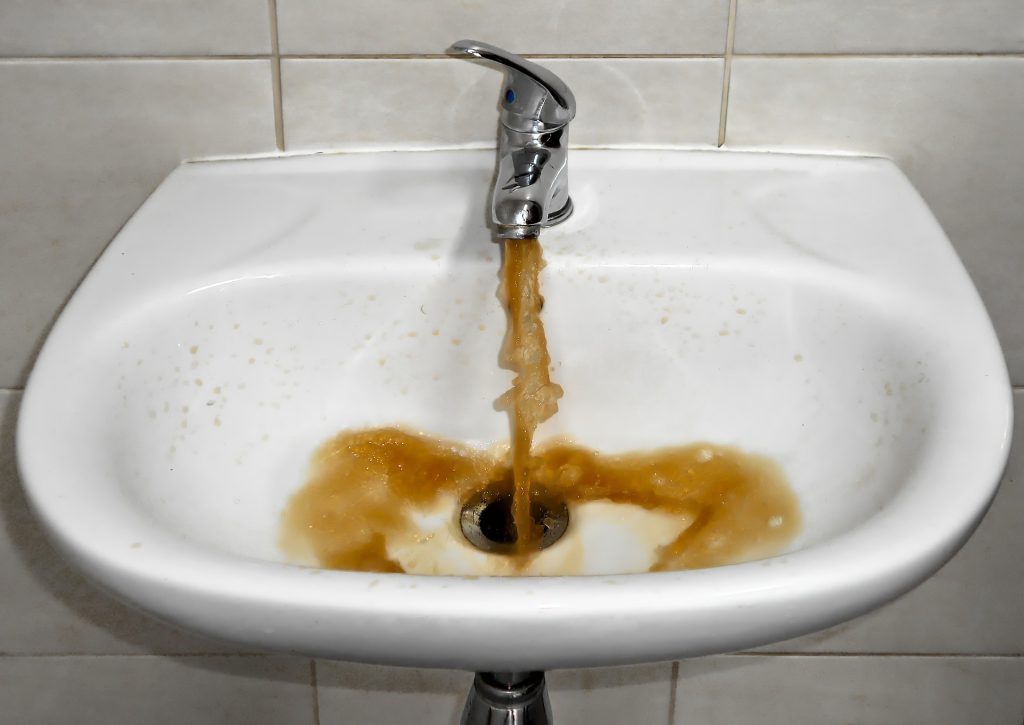If you have ever turned on a faucet to find that your hot water is discolored or encountered discolored toilet water, you may have felt more than a bit disconcerted by it. However, discolored water is far more common in many households than you might think.
The first thing you need to do is determine what has caused the discolored water. Once you’ve figured this out, you’ll know how to correct the problem. Let’s look at some of the common causes of discolored water.
Water Main Issues
If you awake to find that your faucets have gone from running clear water to running dirty water overnight, the problem can well be coming from outside your home. City or county water lines can develop breaks or undergo maintenance that stirs up dirt and other debris. There are also times when they flush the pipes. If you see discolored water in your faucets, tubs and toilets, the cause is most likely coming from your municipal water lines.
The only thing you can do in a case like this is to wait it out. The discoloration will clear once the work has stopped and the lines have been flushed. The only action you should be taking is not to use your hot water until the water runs clear again to prevent any sediment from being sucked into your water heater.
However, if you are experiencing discolored water coming to you from your supplier’s lines often or for a sustained period, you should take action by contacting them to discuss what they are doing to get it under control. In the meantime, you might consider contacting a plumbing professional to install a water filter to help with the situation.
Corrosion
If you live in an older home and haven’t updated the plumbing, you might experience discolored water due to corrosion in your pipes. Older pipes are usually made of galvanized steel that has rusted over time, leaving bits of rusty debris that mix with the water and cause it to exit the tap looking dirty. You can usually determine if this is the case quite easily, because not all faucets may be affected, and the water will run clear again after it’s had a chance to flush out the particles in the pipes.
Though you can install a filter to clean your water, it would be better to opt for a longer-term option to correct the problem. American Home Water and Air professionals can locate the corroded pipes and replace them for you. Failure to address the more significant problem will eventually lead to the subject pipe corroding and leaking or bursting open due to the pressure coursing through the lines.
Water Table Changes
If you get your water from a well on your property, fluctuations in the water table create the presence of excess iron in your water, giving a dirty appearance to the water entering your home.
Since this is a natural occurrence, there isn’t much you can do to control it at the source. However, you can use a quality iron remover to reduce the amount of iron leaching into your water and creating discoloration.
Excessive Demand
Many areas in and around Phoenix draw their water from rivers. During droughts, the high demand for the lowered water levels can draw dirt and sediment from the river bottom into the water supply, leaving you with discolored water.
If the water coming from your faucets and filling your toilet or tub is noticeably discolored during periods of drought, you can combat the problem with a sediment filter. Ask your plumbing professional about having one installed if this is a recurring problem.
Failed Filtration
If there is some issue with your supplier’s filtration system, you can end up with discolored water in your home. You should contact them to see if they are experiencing problems.
If this problem continues and you can’t find a solution at the source, you can install a whole-home water filtration system to clear up the issue.
Why is My Hot Water Discolored?
If only your hot water is discolored, you may have an issue with the lines leading from your water heater or the water heater itself.
The most common cause of discolored hot water is an accumulation of sediment and minerals inside the water heater. Sediment forms from tiny particles entering the water heater and collecting inside the tank. This sediment can settle to the bottom and build up over time. Minerals in your water supply can also build up in your water heater’s pipes and tank.
Not only can the presence of these cause discoloration of your hot water, but they can also create problems with the function of your water heater if left to collect for too long. Over time, the efficiency and lifespan of the unit will be reduced, and the quality of your hot water will suffer.
The best way to prevent this issue is by routinely flushing the water heater’s tank so that it never becomes a problem. If you’ve not practiced proper maintenance of your water heater or have moved into a home where it was previously neglected, you should flush the unit as soon as possible. You can do this yourself, or you can contact a professional to do so for you. A qualified plumber can not only take care of the problem but perform additional preventative maintenance.
The other possibility is that the pipes leading to or from your water heater have corroded and discolored your water with rust particles flaking from the inner surface. If you have plastic or copper pipes, this will not be an issue, but if you live in an older home, you should check the lines for signs of aging that lead to corrosion.
If your hot water is continually discolored and your pipes are older, replacing all the affected lines may be best. Your plumbing professionals at AHWA can provide an evaluation and estimate for removing and replacing failing pipes before they become a more significant issue.
[related_posts_by_tax posts_per_page="3" format="thumbnails" image_size="medium"]









